Occupational environment monitoring at a tire manufacturing factory
99,000 ₫
Note: The above price is calculated for one sample, and the price may fluctuate depending on the area of the environment to be monitored and market movements. For more accurate pricing support, please refer to the price list or contact our consulting staff directly.
Monitoring the environment of a tire manufacturing factory is a session of collecting, analyzing, and evaluating workplace factors that may be harmful to workers’ health.
Table of Contents
Toggle1. Overview of the Tire Manufacturing Factory
a. What is a Tire Manufacturing Factory?
Factory for tire production is a specialized production facility aimed at manufacturing various types of tires for use in the automobile and motorcycle industry. This factory is usually equipped with modern production lines and high-tech machinery to produce tires according to quality standards and technical requirements.
Tire manufacturing factories often apply advanced technology and automated production processes to ensure the quality and performance of the tires produced.

b. Production stages in a tire manufacturing factory
Production stages in a tire manufacturing factory typically include the following:
- Material preparation: Preparing main materials including rubber, additives (carbon black, structuring agents, softeners, reinforcements, antioxidants), and fabric cords.
- Mixing and processing rubber: Raw materials are mixed together to create a rubber compound. Then, the rubber compound is processed and prepared for the next stages.
- Creating the tire carcass: The rubber compound is put into processing machines to form the tire carcass. This process includes softening and rolling the rubber to shape the initial form of the carcass.
- Tread processing: The tread of the tire is created through processes such as cutting, grinding, polishing, and pressing. Grooves and tire patterns are also formed during this stage.
- Attaching liner and cord layers: The liner (anti-wear material) and cord layers (usually fabric) are attached to the carcass to provide stiffness and durability for the tire.
- Assembly and vulcanization: Rubber layers, including tread, liner, and cord, are assembled onto the carcass. Then, the tire is placed into a mold and undergoes vulcanization, which means heating the tire to bond the rubber components together and create a solid tire structure.
- Quality inspection: Completed tires are inspected to ensure compliance with standards and technical specifications. Inspections may include checking durability, adhesion, wear resistance, and size accuracy.
- Packing and transportation: After quality checks, tires are packed and prepared for shipment to retail outlets or distribution dealers.

c. Types of machinery used in tire manufacturing factories
In tire manufacturing factories, various machines are used for production and processing. Some common machines include:
- Rubber mixing machine: Used to mix rubber and additives into a homogeneous rubber compound.
- Carcass rolling and processing machines: Used to soften and roll the rubber into the initial carcass shape. Other processing machines are also used to shape and refine the carcass.
- Cutting, grinding, and polishing machines: Used to process the tire tread, including cutting grooves and tread patterns, smoothing the surface, and polishing for finishing and design features.
- Liner and cord attaching machines: Used to attach anti-wear liners and cord layers (usually fabric) onto the tire carcass.
- Assembly and vulcanization machines: Assembly machines position rubber layers, including tread, liner, and cord, onto the carcass. Vulcanization machines then heat the tire to bond rubber components together.
- Quality inspection machines: Specialized machines are used to test durability, adhesion, wear resistance, and other tire characteristics.

d. Occupational diseases for workers in tire manufacturing factories
Workers in tire manufacturing factories may encounter several occupational diseases related to the working environment and production processes. Common occupational diseases include:
- Respiratory diseases: Workers may be exposed to fine particles and chemicals during tire production, causing respiratory issues such as bronchitis, asthma, pneumonia, and irritation of the nose and throat.
- Skin diseases: Contact with chemicals during tire production may cause skin irritation, dermatitis, rashes, and allergic reactions.
- Hand-related diseases: Tasks involving tools and machinery may cause musculoskeletal issues, hand injuries, muscle and tendon problems. Contact with chemicals can also damage skin and increase infection risks.
- Toxicity-related diseases: Some chemicals used in tire production may cause long-term toxic effects, affecting the liver, kidneys, and nervous system.
- Occupational accidents: Operating machinery and equipment carries risks of accidents such as collisions, falls, cuts, crushing, explosions, or being struck.
To prevent and minimize occupational diseases, implementing labor safety measures, using personal protective equipment, following safe work procedures, and controlling the work environment are crucial in tire manufacturing factories.

e. Popular types of tires on the market
There are various types of tires available in the market for different vehicles and purposes. Common types include:
- Car tires: Widely used on passenger cars. Designed to provide good road grip, stability, and comfortable driving.
- Truck tires: Used on trucks and buses. Capable of carrying heavy loads with high road grip and wear resistance.
- Motorcycle tires: Specifically designed for motorcycles. Popular types include road tires, off-road tires, and racing tires.
- Bicycle tires: Used on bicycles, including city bikes, mountain bikes, racing bikes, and electric bicycles. Variants include road tires, off-road tires, and racing tires.
- Agricultural vehicle tires: Used on tractors, harvesters, excavators, and other farm vehicles. Resistant to wear and capable of handling heavy loads on rural terrain.
- Small vehicle tires (electric vehicles, small motorcycles): Used for small-sized vehicles such as electric scooters and small motorcycles.
2. Overview of Occupational Environment Monitoring Services
a. What is occupational environment monitoring at a tire factory?
Occupational environment monitoring (or workplace environmental measurement) at a tire factory involves collecting, evaluating, and analyzing measurements of workplace environmental factors to implement timely measures, minimize hazards to workers’ health, and prevent occupational diseases. Environment monitoring is mandatory for tire factories.
It plays a crucial role in protecting and enhancing worker health because workers are the main asset of a company and directly generate profit. Workers frequently exposed to harmful factors beyond permissible limits may experience health impacts and occupational diseases.
REGISTER OCCUPATIONAL ENVIRONMENT MONITORING SERVICE
b. Nam Viet occupational environment monitoring program
Nam Viet’s occupational environment monitoring program is developed by engineers specializing in labor safety and environmental protection. To ensure worker health and safety, the program uses modern measurement methods to monitor air, water, microclimate, physical, and dust factors in the workplace. This program is essential for maintaining a safe work environment and protecting worker health.
Additionally, Nam Viet’s program contributes to research and development of new solutions to improve workplace environmental quality. With a professional and dedicated monitoring team, Nam Viet’s exclusive program is a breakthrough in labor safety management and environmental protection in Vietnam.

c. Standardization in occupational environment measurement procedures
Standardization in Nam Viet’s measurement procedures ensures accuracy and reliability. The program follows recognized standards and procedures of Ho Chi Minh City Department of Health, ensuring reliable data for evaluating the work environment and making decisions to protect worker health.
These procedures also guarantee that measurements are conducted by highly qualified monitoring specialists with years of experience, allowing managers and experts to trust results from An Toan Nam Viet for accurate, valuable decisions in worker health and environmental protection.
By applying standardization, Nam Viet demonstrates its commitment to a safe workplace and contributes positively to labor safety and environmental management in Vietnam.
d. Reporting results of tire factory monitoring
Monitoring results are prepared according to Form 04, Appendix III issued with Decree 44/2016/ND-CP and made in two copies: one sent to the contracting factory and one retained by the monitoring organization.
Retention time of results is indefinite, as prescribed by law.

e. Frequency of occupational environment monitoring as per law
According to Clause 2, Article 18, Law on Occupational Safety and Health 84/2015/QH13, employers must organize monitoring of harmful factors at least once a year.
f. Deadline for submitting occupational environment monitoring reports
Reports must be submitted before December 31 annually. Factories are required to submit results to the local Department of Health at the location of their headquarters and where employees work.
When there are changes in technology, production processes, or facility upgrades that may introduce new hazards, factories must update occupational hygiene records regarding harmful factors to be monitored.
g. Penalties for violations of occupational environment monitoring for employers
According to Article 27, Decree 12/2022/ND-CP dated January 17, 2022, on administrative penalties in labor, social insurance, and Vietnamese workers working abroad under contract:
- Clause 2: Fine from 2,000,000 to 5,000,000 VND for not publicly notifying employees at the monitoring site and workplace about monitoring results and hazard assessments immediately.
- Clause 3: Fine from 20,000,000 to 40,000,000 VND for failing to perform monitoring to control health hazards as per the law.
- Clause 4: Fine from 40,000,000 to 60,000,000 VND for collaborating with monitoring organizations to commit fraud during monitoring, without criminal liability.
3. Harmful Environmental Factors for Workers in Tire Manufacturing Factories
Workers in tire manufacturing factories may be exposed to various harmful environmental factors. Here are some common environmental factors in the tire production industry:
- Dust and fine particles: The tire manufacturing process can generate dust and fine particles from materials such as rubber and chemicals. Long-term exposure to this dust and particles can cause eye, respiratory, and skin irritation.
- Chemicals: Tire production requires the use of chemicals such as vulcanizing compounds, solvents, cleaning agents, and adhesives. Exposure to these chemicals can cause skin, eye, respiratory, and digestive irritation. Some chemicals may cause toxicity if exposure occurs over a long period.
- Emissions and fumes: Tire manufacturing can produce emissions and fumes from processes such as vulcanization and drying. These emissions may contain air pollutants such as volatile organic compounds and harmful chemical compounds. Exposure to these fumes can irritate the eyes, respiratory system, and nervous system.
- Noise: Tire production often involves noise from machinery and equipment. Noise levels may exceed safety limits, leading to hearing issues such as hearing loss and tinnitus.
- Temperature and humidity: Certain stages of tire production require specific temperature and humidity conditions. Poor environmental conditions, such as high temperature and high humidity, can cause fatigue, discomfort, and affect workers’ health and performance.
REGISTER FOR OCCUPATIONAL ENVIRONMENT MONITORING SERVICE
4. Measures to Improve the Working Environment in Tire Manufacturing Factories
To improve the working environment in tire factories and protect workers’ health, the following measures can be applied:
- Ventilation and dust extraction systems: Install efficient ventilation and dust extraction systems to remove dust and fine particles from the air. This helps reduce exposure to respiratory and eye irritants.
- Use safe chemicals: Use safe and environmentally friendly chemicals to reduce exposure to harmful substances. In addition, implement personal protective measures such as wearing masks, gloves, goggles, and protective clothing when handling chemicals.
- Noise control: Apply soundproofing, insulation, and hearing protection measures to reduce noise at the source and ensure that noise levels do not exceed safety limits. Provide protective ear equipment such as noise-canceling earplugs or earmuffs for workers.
- Adjust temperature and humidity: Ensure comfortable working conditions with appropriate temperature and humidity. Provide air conditioning or other measures to control temperature and humidity in the factory.
- Training and education: Train workers on occupational safety, proper use of personal protective equipment, and safety and environmental protection measures. Educate them on potential hazards, waste handling, and safe working procedures.
- Implement inspection and quality control: Regularly inspect and control the quality of raw materials, products, and production processes to ensure compliance with safety regulations and environmental protection standards.
- Periodically conduct occupational environment monitoring in factories, collect and analyze harmful factors affecting workers, and adjust to reduce risks to prevent occupational diseases.
5. Benefits of Periodic Monitoring of Tire Manufacturing Factories
An Toan Nam Viet provides enterprises with significant benefits when using occupational environment monitoring services in accordance with Decree 44/2016/ND-CP on managing and controlling harmful factors in the working environment affecting workers.
- Enterprises can proactively control harmful factors in their workshops or factories.
- Receive recommendations on measures to minimize harmful factors and improve the quality of the working environment.
- Indirectly protect human resources, the key factor in enterprise development.
- Reduce the impact of occupational diseases on human health, thereby minimizing future treatment costs.
- Improved worker health leads to consistent product quality and production output.
- Ensure compliance with occupational safety laws, avoiding legal risks.
- Enhance credibility and professionalism in all aspects, thereby elevating the enterprise’s brand value.
Nam Viet’s occupational environment monitoring service is a solution to reduce the impact of occupational diseases, contributing to a clean and high-quality working environment.

6. National Occupational Environment Monitoring Center
Occupational Environment Monitoring Center of Nam Viet is a professional unit specializing in monitoring and measuring the quality of the working environment across all provinces in Vietnam. With an experienced team of monitoring specialists, the center uses modern measurement equipment ensuring accuracy and reliability.
In addition to providing monitoring services, the center assists clients in planning, handling, and tracking occupational environment issues. With the motto “customer-centered,” the center focuses on client satisfaction, meets all client needs, and is committed to offering the best solutions for enterprises.
REGISTER FOR OCCUPATIONAL ENVIRONMENT MONITORING SERVICE
With investments in technology, equipment, and human resources, Nam Viet’s monitoring center has become one of the most reputable units in the field of occupational environment monitoring in Ho Chi Minh City, with the following goals:
- We always value our brand reputation and the quality of our service products.
- We provide customers with the best and most suitable services possible.
- Alongside our team of experienced Masters and Engineers aiming to protect the environment and benefit enterprises.
- By choosing Nam Viet Environmental Monitoring team, your company will receive professional service from experts in the monitoring field and enjoy the best cost advantages.
The occupational environment monitoring process at Nam Viet includes the following basic steps:
- Before conducting occupational environment monitoring, our company ensures that machinery and equipment for monitoring are calibrated according to legal regulations.
- Implement the occupational environment monitoring procedures as committed to the Department of Health.
- Honestly report occupational environment monitoring results to the employer.
- If the monitoring results indicate unsafe conditions for workers, Nam Viet will support by providing corrective solutions, and the workplace will implement as follows:
- Implement measures to improve working conditions to minimize the impact of harmful factors and prevent occupational diseases.
- Organize health examinations to detect occupational and related diseases early for workers in unsafe environments.
- Provide in-kind benefits to workers in accordance with labor law regulations.

7. Occupational Environment Monitoring Price Quote
To help enterprises conduct occupational environment monitoring professionally and effectively, Nam Viet provides clients with a price list for occupational environment monitoring services with high quality and reasonable costs.
- Our price list provides detailed information about the costs of the monitoring services we offer, including expenses for travel, measurement, analysis, and reporting results. Clients can fully trust the accuracy and reliability of the monitoring reports we provide.
- We are committed to offering the most competitive and reasonable prices on the market and are always ready to provide quick and professional consultation for any questions about monitoring services.
- With Nam Viet’s price list, clients can easily select service packages suitable for their needs. We are committed to delivering the highest client satisfaction with professional service quality.
No comments yet

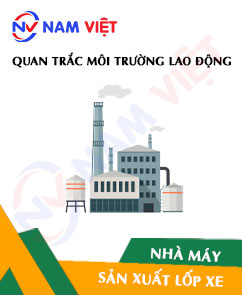
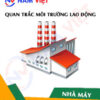
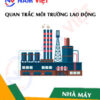

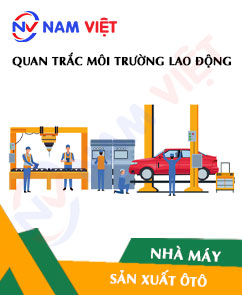

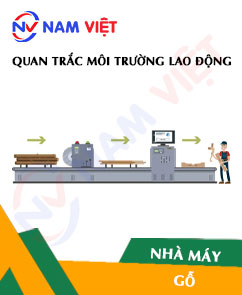

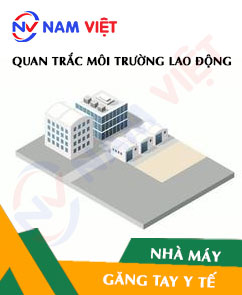
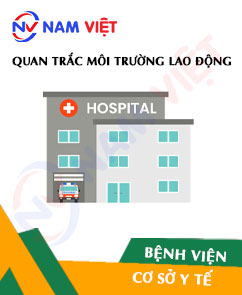
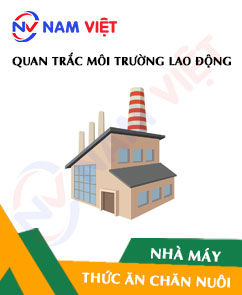
Review Occupational environment monitoring at a tire manufacturing factory
There are no reviews yet.